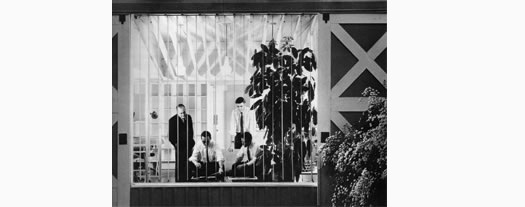
Design Observer alerts us to a new website devoted to the work of Lester Beall, always my favorite of the cadre of mid-century corporate identity designers for the color, energy and sheer American-ness of his design. I had just been thinking about his letterhead last week, a propos of Letterheady, since it had a very chic LB picked out in perforations.
I discuss Beall’s work for Connecticut General Life Insurance Company in my dissertation, but what most fascinated me about his practice was the architecture of it. In 1952, Beall bought a farm near Danbury, Connecticut, and renamed it Dumbarton Farm after an early Scottish ancestor. A barn on the property became his studio (though he raised a highly photogenic flock of sheep under the same roof), while wife Dorothy Miller Beall filled the farmhouse with a collection of early-American furniture and artifacts. Beall fancied himself a New England type, a collector of all things colonial, but preferred a modern environment for work, and created for himself a miniature version of the modernist corporate headquarters.
By 1955 Beall found that he could conduct his business entirely from the country, and closed the New York office. In-town meetings were conducted over lunch; clients could be ferried from the train station by an on-call car service. One can imagine CG president Frazer Wilde’s reaction to a visit to the office: the luxury of the car, the beauty of the pastoral views, the pale yellow of the barn, the simplicity of the interior. This was what Wilde wanted for his employees, and Beall already had it. A striking nighttime photograph of Beall’s office, used in a self-promotional brochure he published in 1962, strongly suggests some aesthetic overlap between his barn and Connecticut General.
In the image, the cross-hatched barn doors have been slid back to reveal a plate-glass square, close to 12’ by 12’. Overhead, the thin white beams of the roof recede, casting a complex of shadows on the gable. The thin vertical blinds are turned on end, so one can see Beall and his employees gathered around a set of presentation boards, sitting on a couch that is either Knoll or very like it. To the left, a row of drafting desks runs to the back wall, which is covered with a shallow grid of built-in shelving. I have been unable to find mention by any of the participants of Beall’s interior architecture, but the combination of country and modernism, the stripped white ceiling and the Knoll sofa, the desks and the modular shelving, suggests a homemade, and handmade (by Beall and his son, Lester Jr.) Connecticut General bay. Perhaps the aesthetic was merely in the air, in which case Beall’s office only means that he was closer in spirit to Wilde, architect Gordon Bunshaft and interior designer Florence Knoll than any of them ever knew.
